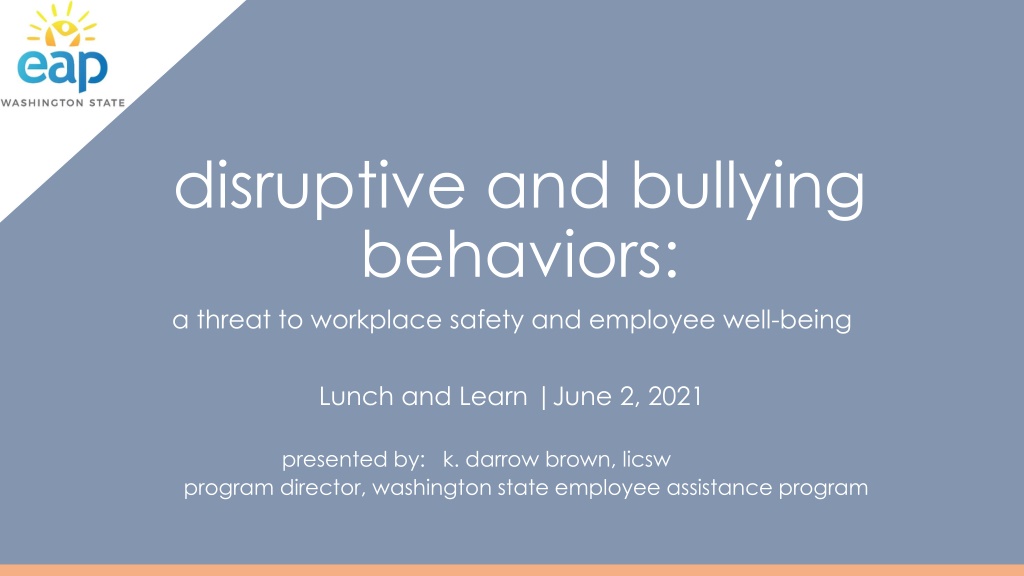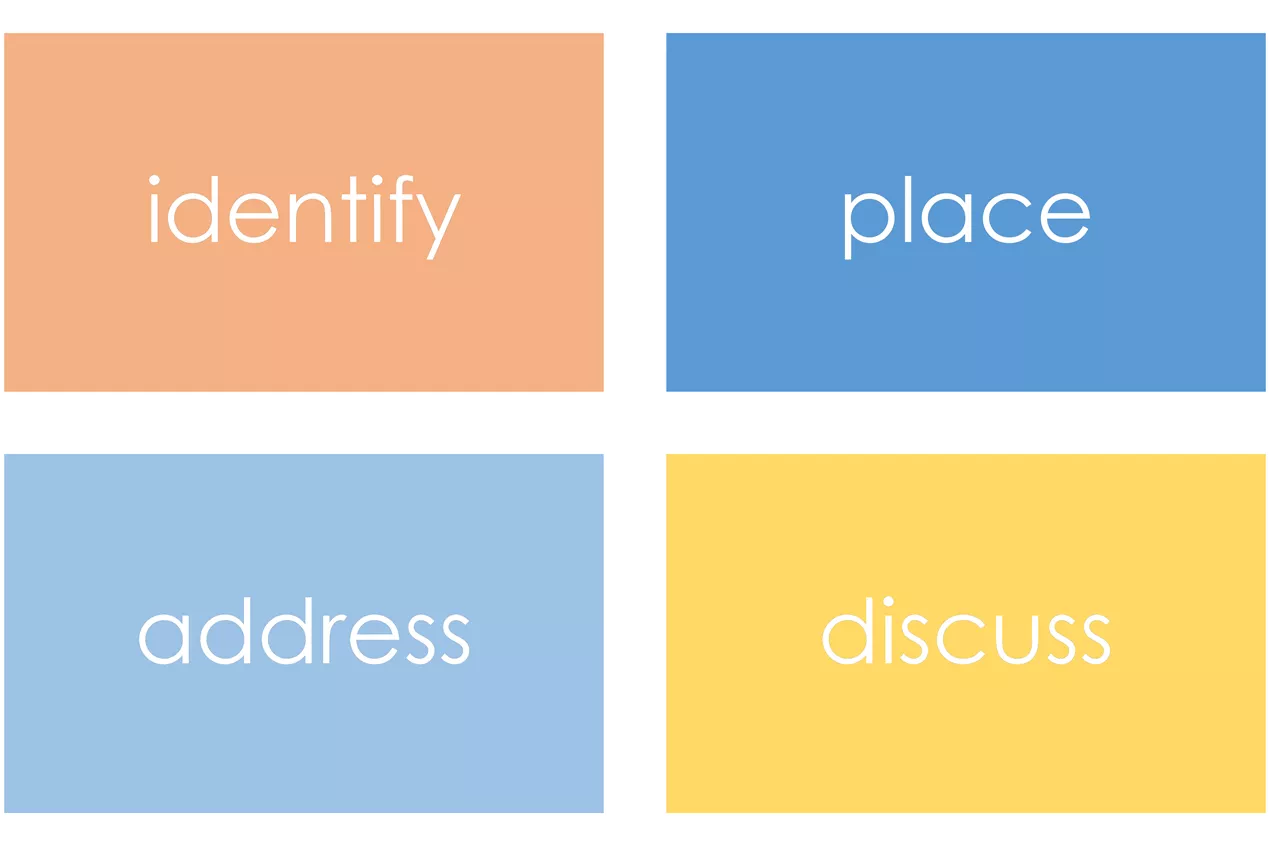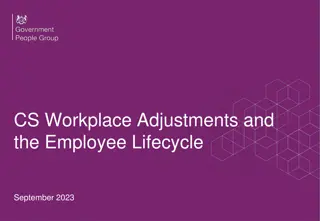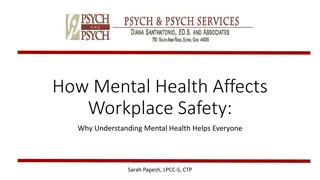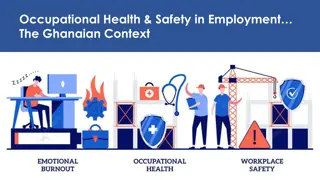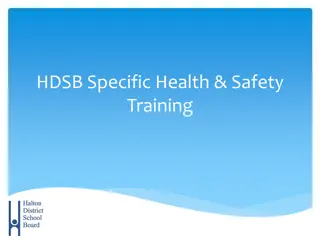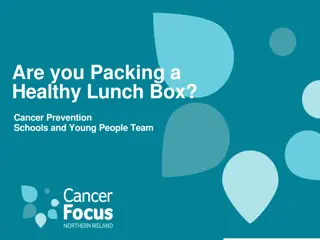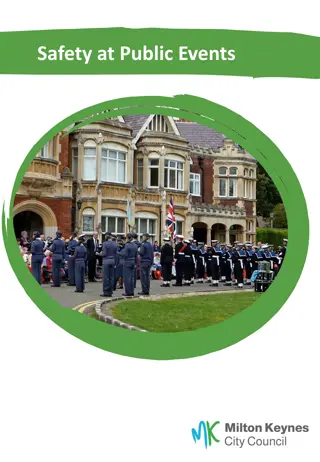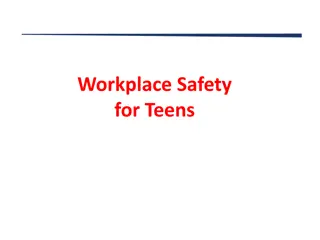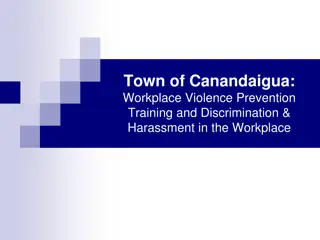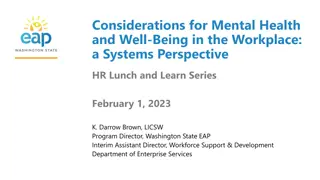Workplace Safety and Well-being Lunch and Learn Event Overview
This Lunch and Learn event held on June 2, 2021, addressed disruptive and bullying behaviors as threats to workplace safety and employee well-being. Key topics included identifying, addressing, and discussing such behaviors, along with statistics on civility in the workplace and challenges faced due to incivility. The event highlighted the continuum of disruptive behaviors, ranging from stalking to mild bullying, and discussed inappropriate behaviors that impact workplace harmony. Insights on the impact of incivility on job performance and employee turnover were shared, underscoring the importance of fostering a respectful work environment.
Download Presentation

Please find below an Image/Link to download the presentation.
The content on the website is provided AS IS for your information and personal use only. It may not be sold, licensed, or shared on other websites without obtaining consent from the author. Download presentation by click this link. If you encounter any issues during the download, it is possible that the publisher has removed the file from their server.
E N D
Presentation Transcript
disruptive and bullying behaviors: a threat to workplace safety and employee well-being Lunch and Learn |June 2, 2021 presented by: k. darrow brown, licsw program director, washington state employee assistance program
objectives identify place address discuss
some good news 89% of those who work with others describing their place of employment as very or somewhat civil. Source: Civility in American 2019 Solutions for Tomorrow, Weber Shandwick
Experienced Incivility at Past or Present Job 50% 45% 43% 40% 38% 37% 35% 34% 34% 33% 30% 29% 25% 23% 20% 15% 10% 5% 0% 2011 2012 2013 2014 2016 2017 2018 2019
some challenges 30% managers had fired or threatened to fire someone due to incivility employees said they had quit a job due to an incivility in the workplace workers indicated that workplace incivility affected work performance 25% 87%
disruptive behaviors Disruptive behavior is inappropriate behavior that interferes with the functioning and flow of the workplace (stonybrook.edu) A behavior that has a negative impact on the emotional or physical well- being of persons in the workplace. Any negative behavior that has the potential to distract, undermine, or physically/psychologically damage team members. (ctileadership.com)
disruptive behaviors continuum stalking serious injury, death inappropriate moderate to severe bullying Stated threats disrespectful, rude, discourteous Physical violence domestic/intimate partner violence mild bullying
inappropriate behaviors making rude remarks displaying personal effects in the work space that could be perceived as strange or threatening demeaning or degrading statements inappropriate jokes or pranks swearing in public oversharing of personal life or professional life details
disrespectful behaviors Public humiliation Criticizing, ridiculing, or dismissing achievements Shouting Degrading an employee/coworker in front of other people Inappropriate sarcasm Speaking in a condescending or belittling way Swearing at another person Dismissive or negative gesturing when someone else is speaking Talking over another person; poor behavior in meetings Refusing to speak to another person for work purposes Discounting the person s thoughts or feelings ( Oh, that s silly ) in meetings Stealing credit for work done by others
bullying a persistent pattern of mistreatment from others in the workplace that causes either physical or emotional harm. repetitive and systematic engagement of interpersonally abusive behaviors that negatively affect both the targeted individual and the work organization repeated, health-harming mistreatment of one or more persons (the targets) by one or more perpetrators
bullying myths If you are bullied, you are weak. Only men bully. Most bullies are managers. Bullies work alone. Ignore the bully. The problem will go away. It s not bullying, it s just tough management.
tough boss Objective, fair, and professional. Self-controlled and unemotional. Performance-focused insistent upon meeting high standards and holding employees accountable for meeting those expectations. Organizationally oriented consistently operating to achieve the best interests of the organization.
bully boss frequently misuses power and authority. focuses on personal self-interest, as opposed to the good of the organization. has emotional outbursts. treats their employees inconsistently and unfairly. appears to operate with intent to cause his or her target some kind of pain or personal distress.
bullying - mild Ignoring someone by not responding to communications or requests for information or assistance Dismissive interpersonal communications Assigning blame Providing negative feedback in spite of successful performance Periodic oversights of leaving a person out of communications (including email) or social situations Delaying or not providing crucial information
bullying moderate to severe Dismissive public responses to communications Dismissive interpersonal communications (shut down a conversation and not allow the other person to communicate his/her perspective) Ongoing misinformation ( forgetting to share need-to- know information which makes the other person look foolish or humiliated by not knowing ) Sabotage and/or creating a situation of impossible demands whereby the other person is left out or will fail to meet expectations
bullying moderate to severe Starting gossip campaigns Publicly ridicule, insult, make jokes about person in his/her presence Routinely blaming and criticizing Intimidation by glaring, acting forceful, interrupting, shutting down another person (also includes contradictions and silent treatment) Pounding fist on desk, yelling, screaming, or throwing tantrums in front of others to humiliate the person Retaliation for the person reporting or asking for help
self-reflection Have you exhibited any of the behaviors at work? If so, which ones and how often? Have you ever received feedback about negative behaviors at work? If so, do you have a plan to address the concerns and make things right?
the impact physical health mental health on the job high blood pressure digestive issues headaches difficulty sleeping decreased appetite fatigue chronic worry about work anxiety depression hopelessness suicidal thoughts self doubt decline in job performance work avoidance difficulty focusing difficulty making decisions increase in mistakes/errors
addressing conduct a self-assessment be direct, calm and professional while calling the behavior out document, document, document know your workplace policies regarding harassment, hostile work environments, etc. speak to your supervisor or your supervisor s supervisor talk to HR
addressing Find a quiet, private space Arrange yourself so your access to exits are not blocked Ask open-ended questions Listen and let the employee explain in their own words what s happening Provide clear feedback based on your own observations Avoid language that blames or judges Collaborate with the employee to develop a plan Provide resources that align with the plan and with your role as supervisor
addressing create policies that specifically address disruptive behavior, bullying and hostile work environments design, develop and implement workplace culture initiatives around civility, psychological safety and diversity, equity and inclusion cultivate culture
training opportunities Inclusive Leadership: Building a Psychologically Safe Team Culture Workshop - https://des.wa.gov/training/CourseDescription/2190 - Workforce Learning and Performance, Department Enterprise Services Managing Job Stress - https://des.wa.gov/training/CourseDescription/195 - Workforce Learning and Performance, Department Enterprise Services Violence in the Workplace - https://des.wa.gov/training/CourseDescription/198 - Workforce Learning and Performance, Department Enterprise Services
resources Workplace Bullying Institute www.workplacebullying.org Civility in America Survey 2019 Weber Shandwick - https://www.webershandwick.com/wp- content/uploads/2019/06/CivilityInAmerica2019SolutionsforTomorrow.pdf American Psychological Assocation, Center for Organizational Excellence - https://www.apaexcellence.org/resources/special-topics/workplace-bullying Workplace bullying: a tale of adverse consequences Innovations in Clinical Neuroscience - (Sansone RA, Sansone LA. Innov Clin Neurosci. 2015 Jan-Feb;12(1-2):32-7. PMID: 25852978; PMCID: PMC4382139.) The Society for Human Resources Management toolkit - (The Society for Human Resource Management - https://www.shrm.org/resourcesandtools/tools-and- samples/toolkits/pages/managingdifficultemployeesa.aspx)
resources High Performing Teams Need Psychological Safety Harvard Business Review - https://hbr.org/2017/08/high-performing-teams-need-psychological-safety-heres-how- to-create-it How Do You Create Psychological Safety at Work Amy Edmondson - https://www.youtube.com/watch?v=U_35pAviSnI Creating Psychological Safety in the Workplace Harvarad Business Review - https://hbr.org/podcast/2019/01/creating-psychological-safety-in-the-workplace
the washington state eap 877 313 4455 eap.wa.gov
